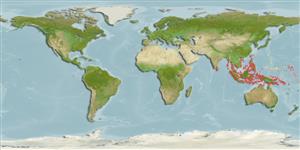Teleostei (teleosts) >
Gobiiformes (Gobies) >
Gobiidae (Gobies) > Gobiinae
Etymology: Cryptocentroides: Greek, kryptos = hidden + Greek, kentron = sting (Ref. 45335).
More on author: Seale.
Environment: milieu / climate zone / depth range / distribution range
Ecology
Marine; brackish; reef-associated; depth range 2 - 10 m (Ref. 90102). Tropical; 25°N - 12°S
Western Pacific: Java to the Solomon Islands, north to Yaeyama Islands; Pohnpei in Micronesia.
Size / Weight / Age
Maturity: Lm ? range ? - ? cm
Max length : 8.6 cm TL male/unsexed; (Ref. 7050)
Dorsal spines (total): 7; Dorsal soft rays (total): 11 - 13; Anal spines: 1; Anal soft rays: 12 - 13. Characterized by mottled grey brown body color with about eight large, dark spots along back and diffuse branching bars on side; dorsal, anal and caudal fins yellowish; oblique dark bands on side; united pelvic fins, presence of frenum; longitudinal scale series 70-75; head without scales; greatest depth of body 4.7-5.0 in SL; rounded caudal fin, about equal to heal length (Ref. 90102).
Facultative air-breathing in the genus (Ref. 126274); Inhabits brackish tide pools (Ref. 1602) and sandy mangrove habitats (Ref. 37816). Also found in sand rubble bottoms in 2-10 m (Ref 90102).
Life cycle and mating behavior
Maturities | Reproduction | Spawnings | Egg(s) | Fecundities | Larvae
Myers, R.F., 1991. Micronesian reef fishes. Second Ed. Coral Graphics, Barrigada, Guam. 298 p. (Ref. 1602)
IUCN Red List Status (Ref. 130435)
Threat to humans
Harmless
Human uses
Tools
Special reports
Download XML
Internet sources
Estimates based on models
Preferred temperature (Ref.
123201): 27.4 - 29.3, mean 28.8 °C (based on 1695 cells).
Phylogenetic diversity index (Ref.
82804): PD
50 = 0.6250 [Uniqueness, from 0.5 = low to 2.0 = high].
Bayesian length-weight: a=0.00708 (0.00333 - 0.01504), b=3.09 (2.92 - 3.26), in cm total length, based on LWR estimates for this (Sub)family-body shape (Ref.
93245).
Trophic level (Ref.
69278): 3.3 ±0.3 se; based on size and trophs of closest relatives
Resilience (Ref.
120179): High, minimum population doubling time less than 15 months (Preliminary K or Fecundity.).
Fishing Vulnerability (Ref.
59153): Low vulnerability (10 of 100).
